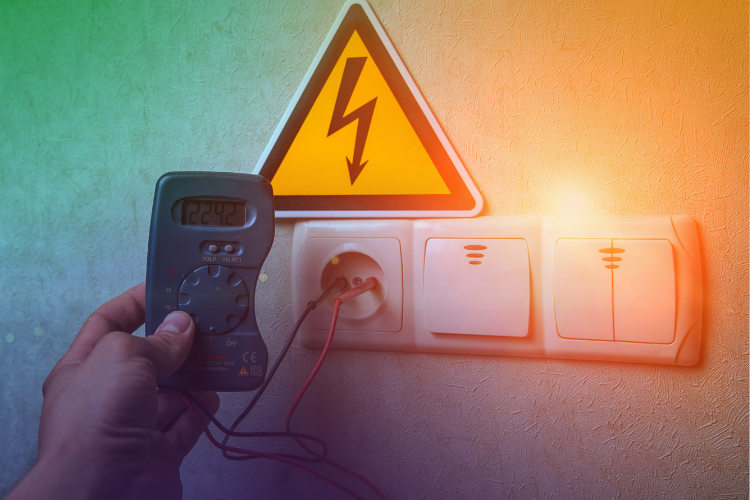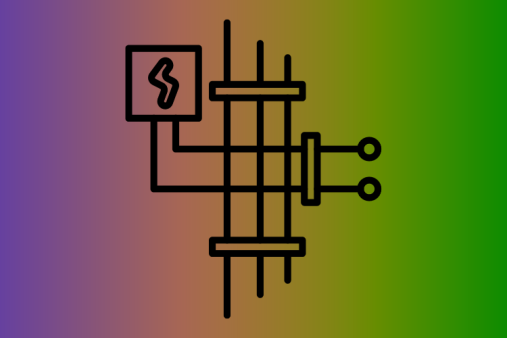Understanding the terminology in the electrical industry can be daunting, whether you're a homeowner tackling a DIY project or a seasoned electrician brushing up on the latest jargon. From AC and DC to transformers and Zener diodes, the world of electrical work is filled with complex terms and concepts.
To help you navigate this intricate field, we've compiled a comprehensive A-Z electrical glossary. This guide will demystify the key terms and provide clear, concise definitions, making it easier for you to understand the components, systems, and safety measures involved in electrical installations and maintenance. Let's illuminate the essential vocabulary that powers the electrical industry and enhances your knowledge and skills.
A
- AC (Alternating Current): An electric current that reverses its direction periodically.
- Adapter: A device that enables compatibility between different types of plugs and sockets.
- Ampere (Amp): The unit of electric current.
- Arcing: A discharge of electricity across a gap, causing a visible spark.
- Armoured Cable: A type of cable protected by a metal sheath, used for underground or external applications.
- Attenuation: The reduction in signal strength during transmission.
B
- Ballast: A device that regulates the current to fluorescent and HID lamps.
- Breaker Panel: A panel that houses circuit breakers for electrical distribution.
- BS 7671: The British Standard for electrical installations, also known as the IET Wiring Regulations.
- Busbar: A conductor that distributes electrical power within a switchboard or substation.
C
- Capacitor: A device that stores and releases electrical energy.
- Circuit: A complete path that allows electrical current to flow.
- Circuit Breaker: A safety device that automatically stops the flow of electricity in a circuit if it becomes overloaded.
- Clamp Meter: A device used to measure current without direct contact with the conductor.
- Coaxial Cable: A type of cable with an inner conductor surrounded by insulation and an outer conductive shield.
- Conduit: A protective tube through which electrical wires are run.
- Consumer Unit: The main control point for an electrical installation in a building, also known as a fuse box.
D
- DC (Direct Current): An electric current that flows in one direction only.
- Dimmer Switch: A switch that allows the brightness of a light to be adjusted.
- Distribution Board: A panel that divides an electrical power feed into subsidiary circuits.
- Double Pole Switch: A switch that can disconnect both the live and neutral wires simultaneously.
- Drop: The voltage loss in a conductor due to its resistance.
E
- Earth (Ground): A safety measure that directs any fault current safely into the ground.
- Earth Leakage: Current that flows through the earth wire due to insulation faults.
- Earthed: Connected to the ground to ensure safety.
- Edison Screw: A type of light bulb fitting, abbreviated as ES.
- Efficiency: The ratio of useful power output to the total power input.
- EIRP (Effective Isotropic Radiated Power): The power radiated by an antenna in a specific direction.
- EMC (Electromagnetic Compatibility): The ability of electrical equipment to operate without interference.
F
- Fault Current: An abnormal flow of electricity due to a fault in the circuit.
- Ferrule: A metal tube crimped over stranded wire to make it easier to insert into a terminal block.
- Fibre Optic Cable: A cable that transmits data as light pulses.
- Fuse: A safety device that protects an electrical circuit by melting and breaking the circuit when the current is too high.
- Fuse Box: A container for fuses and circuit breakers, also known as a consumer unit.
G
- GFCI (Ground Fault Circuit Interrupter): A device that shuts off power when it detects a ground fault.
- Generator: A machine that converts mechanical energy into electrical energy.
- Grounding: Connecting electrical systems to the ground for safety.
- Grommet: A rubber or plastic ring used to protect wires passing through metal plates.
H
- Hertz (Hz): The unit of frequency, equal to one cycle per second.
- High Voltage: Electrical energy at a voltage high enough to cause harm.
- Home Automation: The use of technology to control household systems and appliances.
- Hot Wire: The wire that carries the live current in an electrical circuit.
I
- IEC (International Electrotechnical Commission): An organization that prepares and publishes international standards for electrical technologies.
- Impedance: The total opposition a circuit offers to the flow of alternating current.
- Induction: The generation of an electric current by a changing magnetic field.
- Insulation: Material that resists the flow of electric current, used to protect conductors and prevent electrical shock.
- IP Rating (Ingress Protection): A rating that classifies the degree of protection against dust and water.
J
- Junction Box: An enclosure that protects wire connections.
- Joule: The unit of energy, equal to one watt per second.
K
- Kilowatt (kW): A unit of power equal to 1,000 watts.
- Knockout: A pre-punched hole in electrical boxes and panels that can be removed to allow for the insertion of a cable or conduit.
L
- Lamp: The term for a light bulb.
- LED (Light Emitting Diode): A semiconductor light source that emits light when current flows through it.
- Live Wire: The wire that carries current to the appliance or device.
- Load: The device or appliances that consume electrical power.
- Low Voltage: Electrical systems operating at a relatively low voltage, typically below 50 volts.
M
- MCB (Miniature Circuit Breaker): A small circuit breaker used to protect electrical circuits from overload.
- MCCB (Moulded Case Circuit Breaker): A circuit breaker that can handle higher current ratings than an MCB.
- Megger: A device used to test the insulation resistance of electrical equipment.
- Microcontroller: A compact integrated circuit designed to govern a specific operation in an embedded system.
- Multimeter: A device that can measure voltage, current, and resistance.
N
- Neutral Wire: The wire that carries current back to the source in an electrical circuit.
- Non-conductive: A material that does not conduct electricity.
- NOS (Normally Open Switch): A switch that remains open until activated.
O
- Ohm: The unit of electrical resistance.
- Ohmmeter: A device used to measure electrical resistance.
- Oscilloscope: An instrument used to display and analyze the waveform of electrical signals.
- Overcurrent: A situation where the current exceeds the rated value of the circuit components.
P
- Parallel Circuit: A circuit where the components are connected in parallel, sharing the same voltage.
- PCB (Printed Circuit Board): A board used to mechanically support and electrically connect electronic components.
- Peak Voltage: The maximum voltage value in an alternating current cycle.
- Phase: A term used to describe the timing of the voltage wave in AC power.
- Photovoltaic Cell: A device that converts sunlight directly into electricity.
- PLC (Programmable Logic Controller): An industrial digital computer used to control manufacturing processes.
- Polarity: The direction of current flow in a circuit.
Q
- Q-Factor (Quality Factor): A parameter that describes the damping of oscillatory systems.
- Quadruplex Cable: A type of electrical cable with four conductors used for overhead line installations.
R
- RCD (Residual Current Device): A safety device that disconnects a circuit when it detects an imbalance between live and neutral currents.
- Receptacle: A socket into which a plug is inserted.
- Rectifier: A device that converts AC to DC.
- Relay: An electrically operated switch.
- Resistance: The opposition to the flow of electric current.
- Resistor: A component used to resist the flow of current in a circuit.
- Ring Main: A wiring system for electrical outlets in the UK, where sockets are connected in a loop.
S
- Semiconductor: A material that can conduct electricity under certain conditions.
- Series Circuit: A circuit where the components are connected in a single path.
- Short Circuit: An unintended low-resistance connection between two points in a circuit.
- Socket: A device into which a plug is inserted to make an electrical connection.
- Solenoid: A coil of wire that acts as an electromagnet when carrying current.
- SPDT (Single Pole Double Throw): A switch that can connect one input to one of two outputs.
- Surge Protector: A device that protects electrical equipment from voltage spikes.
T
- Terminal Block: A modular block used to connect multiple wires.
- Three-Phase Power: A type of polyphase system used by electric power distribution grids.
- Transformer: A device that transfers electrical energy between circuits through electromagnetic induction.
- Transistor: A semiconductor device used to amplify or switch electronic signals.
- Tungsten: A metal used in incandescent light bulb filaments.
U
- UPS (Uninterruptible Power Supply): A device that provides backup power when the main power fails.
- UV (Ultraviolet): A type of electromagnetic radiation with a wavelength shorter than visible light.
V
- Volt (V): The unit of electric potential difference or electromotive force.
- Voltage Drop: The reduction in voltage in a part of a circuit between the source and load.
- Voltmeter: A device used to measure electrical potential difference between two points.
W
- Watt (W): The unit of power, equal to one joule per second.
- Wattage: The amount of electrical power expressed in watts.
- Wire Gauge: A measurement of the diameter of a wire.
- Wiring Diagram: A graphical representation of an electrical circuit.
X
- XLR Connector: A type of electrical connector primarily used in professional audio and video electronics.
Y
- Yield: The total electrical output produced by a photovoltaic system.
- Yoke: The metal frame that supports switches and outlets.
Z
- Zero Potential: A point in an electrical circuit that is at the same potential as the earth.
- Zener Diode: A diode that allows current to flow in the reverse direction when a specific voltage is reached.



